Will modern cars, and modern materials, age gracefully?
When we drive our cars, they collect signs of that use—patina, in collector-car speak. The latest issue of Hagerty Drivers Club magazine, in which this article first appeared, explores the delight found in such imperfect cars. To get all this wonder sent to your home, sign up for the club at this link. To read about everything patina online, click here.
***
Hagerty Drivers Club magazine sat down with member Richard Vaughan, a designer who has 30 years of experience in a variety of automotive product development roles at Ford Motor Company, General Motors, and Rivian, to ponder the question: Will Radwood-era (post-1980) cars develop patina?
Vaughan, a graduate of Detroit’s College for Creative Studies and a lifelong car enthusiast, has written six books on Rolls-Royce, Bentley, and Aston Martin and has been a concours organizer and judge for decades. He currently serves on the Advisory Team for the Detroit Concours as well as on the board of directors of the Rolls-Royce Foundation Museum and the Rolls-Royce Owners’ Club.

Hagerty: Tell us what you think patina means in the classic car hobby.
Vaughan: Patina means worn in as opposed to worn out. It’s like if you buy a Ralph Lauren leather club chair, and over the years it becomes worn in and it looks like you’ve enjoyed it, but it’s still beautiful. That’s different from being worn out. Worn out looks like something you need to throw away and replace.
Cars made before the ’80s have several sensory cues that communicate that they’re worn in: smell, touch, feel. For the interior, leather, fabric, carpet, and wood are probably the four primary materials that create these sensory perceptions. On the exterior, it’s metal and chrome. Acrylic lacquer paint was commonplace from the immediate postwar era through the ’70s. Cars had a lot of paint, and it wasn’t quite as glossy as modern paints. When you polish and polish acrylic lacquer over the years, it gets thinner and thinner, and you get those beautiful areas where you can see that someone has maybe polished through the paint a little bit. It has what I would call a luster. That changes the more you polish it, and the cars can take on a really lovely look of being worn. You can tell somebody’s loved it and they use it.
Radwood cars don’t have it?
Vaughan: You can’t get that patina because the technology just doesn’t allow it. Radwood cars all have urethane, or polyurethane, paint finishes, which is a two-stage paint: base coat, clear coat. When the clear coat fails, it starts peeling off and looks like crap. It never looks worn in; instead, it looks great until it looks bad. You’ll see the paint peeling off the clear coat in sheets.
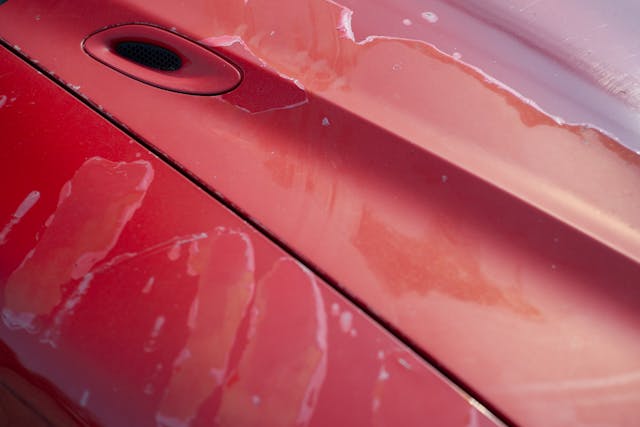
How will exterior plastic trim age?
Vaughan: Plastics for urethane bumpers and that kind of thing often are painted, but the black-molded-in-color plastics just turn gray and look awful and then you’re trying to put Armor All on it. I mean, if you ever see an old Pontiac Aztek or Chevy Avalanche where half the car is covered in that cladding and it’s really faded—you see these little, like, lines? That’s the mold flow of the liquid plastic as it enters the injection molding tool.
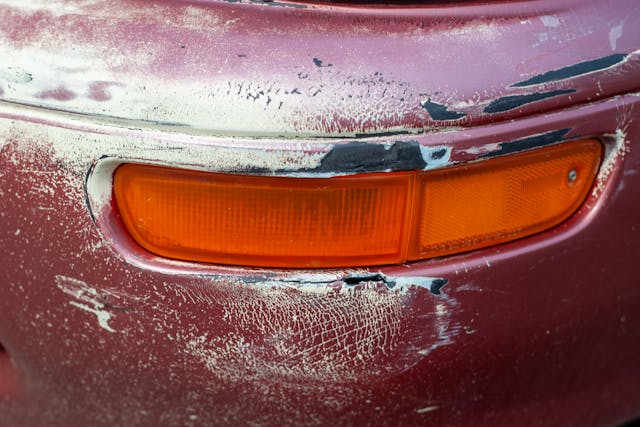
Are there any remedies?
Vaughan: The idea that you could preserve it and it’ll look like it has patina? That is not going to happen. To make the car look good, you’d have to paint the parts, which is kind of weird, as it’s a deviation from the original, but you could paint with a matte finish; it doesn’t have to be a glossy paint. But then it’s not original patina; it’s something else.

So, exterior plastics will not have patina as we know and appreciate patina?
Vaughan: It would be a compromise thing. In the ’80s and into the ’90s carmakers, especially of mass-market cars—this doesn’t apply to a Ferrari or a Bentley—but cars like a Corvette or a Pontiac 6000 STE—they use a lot of PVC—polyvinyl chloride—and a lot of polypropylene, which is the hard material that turns brittle and breaks. In the ’80s, most of that polypropylene, or PP as we call it in the industry, was painted. If you had a beige interior, they would mold the plastics in beige and they would also be painted beige. And, so, two things can happen. You can have the paint starting to separate from, or delaminate from, the substrate, or you can have the plastics getting so brittle that they break and are not repairable. When you’re shopping for a used car from that era, you have to ask: What was the climate where that car lived? If the car came from Texas, every time you take a plastic part off the car, you might as well be sure you have a replacement when you need to put it back on. A car from a place like Seattle where it’s not incredibly hot and there’s not a lot of UV damage, because there’s a lot of cloud cover, might be OK. But eventually time will get all these polypropylene parts.
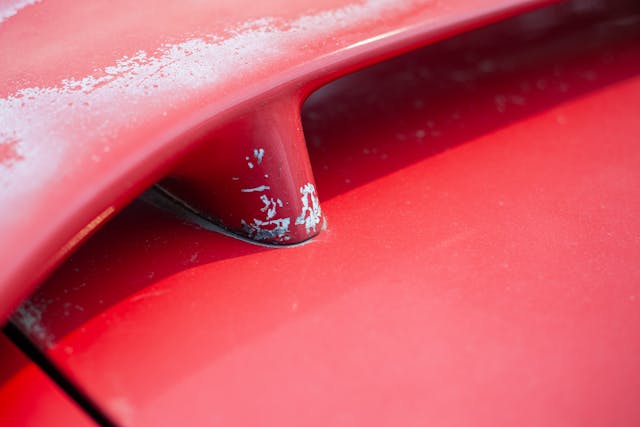
Is it possible that 25 years from now we collectively might decide that it’s charming when those 1990s plastics turn gray?
Vaughan: I’ve been wrong about a lot of things in life, but I don’t think anybody will value that.
Does that mean that in 2050 we will clearly know the difference between a patina-era and a non-patina-era car?
Vaughan: A lot of it will depend on the car. There may be within a certain car community an appreciation for some aspect of the degradation of the materials, like we do today for cars in the ’50s and ’60s that are original. But it’s going to depend on how those materials were used in a particular vehicle.
Here’s another example: leather, which people value a lot, but which has changed and evolved. If you look at a car from the ’60s or ’70s and into the ’80s, leather seating was literally leather sewn together, which can be repaired. And if it’s a really nice car with a thick hide properly dyed rather than simply sprayed with a topcoat of color, you can get a beautiful patina as the leather wears in and you start to see some of the layers of the material. These leathers didn’t have coatings to prevent moisture from getting in. So you could put a cream on the leather, what we call “hide food.”
But in the ’90s, car companies started laminating the leather to protect it and add softness. The leather is laminated to a foam scrim, or backing, to provide some initial softness when you touch the material. But over time, the foam backing starts to break down and de-laminate. And then the leather seat looks like a sleeping bag. Look at, say, a 2007 Aston Martin V8 Vantage or DB9 or an ’07 Bentley Azure convertible. You peer into the interior and you say: My goodness, these seats look terrible, loose and baggy. It’s because the foam has de-laminated and turned to dust. It’s common across most premium automakers—I have this conversation all the time with the Rolls-Royce community.
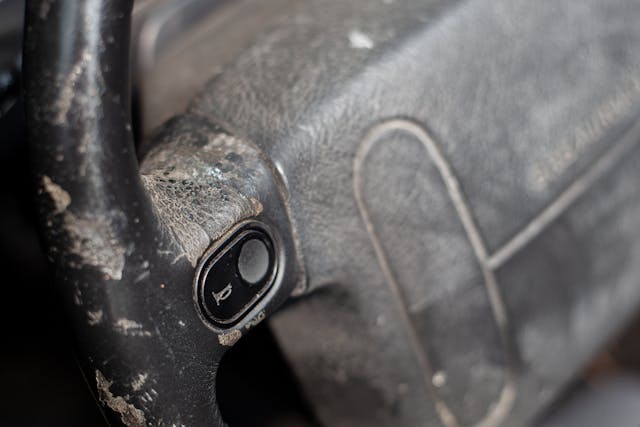
What if that coated leather cracks?
Vaughan: Putting hide food on modern leathers is a waste of time and money because the coatings are designed to prevent, to repel, absorption.
The leather that we of a certain generation loved because of the way it looked, felt, and smelled, and its incredible durability? That traditional material is not considered to have a premium haptic anymore. Today’s luxury buyer would find it to be too hard and firm to the touch. That all changed due to the consumer desire for this sensory perception. It’s also worth pointing out that the cost of leather is very high in more than mere dollars. Leather is extremely heavy.
Foam lamination is also used for vinyl. When we say vinyl, what we usually mean in the car industry is a PVC-coated cloth. And when you talk about synthetic leather that you might find in a modern upscale car like a Lucid or Rivian, that typically is polyurethane. In the business, we would always call that “PU” or “PUR” for polyurethane. And the technical term for these treatments, by the way, is polymeric films.
If we say vinyl, that’s internally [inside car companies and suppliers], because we know that the consumer doesn’t like that word, so we don’t use the word vinyl if we’re talking about the higher-end product that’s polyurethane-based, even though it is indeed just vinyl.
Everybody would consider it vinyl, but the industry often draws a distinction between PVC vinyl and PUR by calling PUR “vegan leather”—but they’re both just petroleum-based polymeric films. The main difference is that the PUR feels more like leather.
None of these plasticized interior materials is going to age well?
Vaughan: Well, that’s one benefit of PVC. It looks good and lasts forever. Everybody’s heard of MB-Tex. You can see a 50-year-old Mercedes and the seats look brand new.

Is PVC vinyl a candidate for patina?
Vaughan: No. Patina implies that it has a worn look. This stuff just doesn’t wear; it can last a very, very long time. Now, of course, like everything, there are really cheap versions where you can wear off the topcoat. But, you know, a car that has a really nice PVC vinyl will keep a new look or good condition look for an extremely long time.
You mentioned Corvette earlier. If we’re talking C4 through C8 Corvettes, in 2050, will there be aftermarket replacements for both interior and exterior plastics?
Vaughan: I think the cost of injection-molding tooling is lower and lower all the time, and 3D printing will allow people to replace parts that would have otherwise not been available. But these are going to be like-new spec. There’s no way in 2050 to make a C7 Corvette have patina as we currently perceive patina.
So, back to our earlier thesis, patina may die after 1980 …
Vaughan: I think your thesis is accurate.

***
Check out the Hagerty Media homepage so you don’t miss a single story, or better yet, bookmark it. To get our best stories delivered right to your inbox, subscribe to our newsletters.
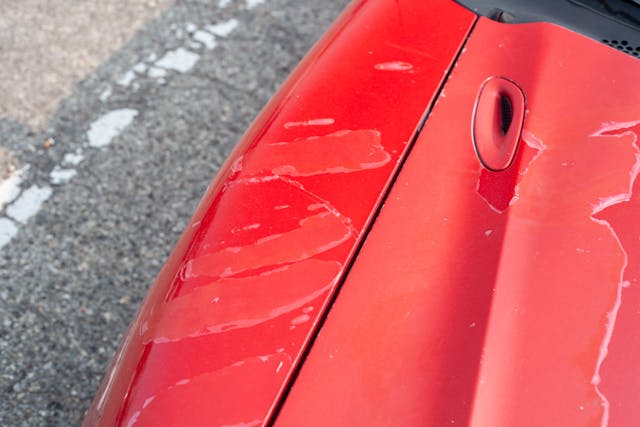


First order of business is to get over Patina. Patina is just a present trend that could and may well be gone in 10 year. Much like the crazy odd graphic paint jobs of the 80’s trends vanish as fast as they appear.
Rat Rods may very well be like the off set wheels and under body LED lights of the 90’s that you seldom see today.
To be honest pealing clear is the patina of the day today.
The real trouble is plastic interior parts that are models specific. The lack of NOS parts today is making it impossible to restore some cars today.
Sure you can restore a 77 Trans Am with most of the reproduction parts. But GM tried to prepare a car for the Rockford Files Movies about 20 years ago and there were no fender chrome trim to be found. They had to remove some from a car in their collection.
I need a surround on my Fiero Shifter but there are none to be found in good shape. No you can’t print it as it is made of several materials and has foamed backed sides that are not printable.
Now on the other hand these cars if stored well will survive very well. My Fiero is almost 40 years old and half the paint is original. I won best paint at a recent Pontiac show with it. Years ago the old paints would fade even on a garaged car and crack.
A 56 Corvette in storage would see the fiberglass deteriorate. But today the SMC body panels have been used 84 and they hold up well with indoor storage. The old stuff would crack, outgas and split where glued.
Also today with the sharing of many parts it has kept many parts easy to find to keep the cars running. Only if it was a short run car like a 88 Fiero are mechanical parts difficult to find for a one year suspension.
Jeeps, Trucks, Camaros, Mustangs, Corvettes are all easy to get parts for and easy to repair. Some A body parts are around too but not all.
But cars with little demand and numbers you will be hard pressed to restore or even keep them running. The cost will our weigh the values. It will become a labor of love to restore some cars.
I think a story on the future and what the next trend could be. With the laws coming where it will be difficult to own or drive collector cars what will we resort to. I am not seeing many changing the cars To EV models. Most hot rodders would rather put their cars vs convert.
Where are we the collectors and racers be able to practice our hobby if CARB limits where and when you can drive?
Will we become outlaws and outcast just to enjoy our hobby?
At the rate it is going we may have to put up big screens in our garages and just sit in our cars and watch old movies on how it used to be. That is for the movies that are still politically correct that you can still buy.
As far as clear coat peeling, I had a 1979 BMW 320i with a silver metallic paint, base coat with clear coat, absolutely flawless, had an accident and hood was replaced, was supposed to be a one week job at body shop but dragged on, asked why it was taking so long, well we painted the hood and it didn’t look right and then we realized it needed the clear coat, well it started to peel about 4 years later, found out that the the proper method per BMW was “wet on wet”, apply base coat, let it flash over several minutes and then apply clear coat and the two bond together preventing the peeling.
The peeling of clear coat will eventually happen no matter how you paint it. The clear coat is destroyed by UV rays and there is yet to be found any clear paint product which will hold up over a lot of time. 15 years is about what anyone can expect.
Well some of this comes down to the application as some plants are more up to date tech wise and produce better application. Others some colors can create issues. down the road too.
But much of it is how the car is used, cared for and where it is kept.
My 40 year old Pontiac paint is stored inside and cared for well with a combination of products.
I also live in the midwest where the sun is not baking it every day in intense sunlight.
There are a number of variables at work here. Most often for failure is lack of care and poor storage as in no garage.
that’s pretty Negative– Being Sooo negative takes the fun out of life–No one is trying to take away our old cars–
Patina is something that just happened – not something that is made. People drove cars with patina for years just because they liked the way it ran but had no interest in painting them. I have always liked the idea of finding old survivors and just driving them without a lot of fussing over them. I would never ‘make’ patina
One thing about the newer generation of cars is even though they are uglier when they finally wear, they take a lot longer to do it. Seeing a 5 year old car with rust back in the day was not uncommon. Now they go well north of 20 years before you see the first spot of rust in a lot of cases. I hate clearcoat, and I will never find peeling clearcoat charming, or cracked and faded plastic, but if it is a neat car and I just like driving it, I will (and do) certainly drive it that way. I need to have at least one nice looking car, but I have absolutely no issues with having things in my collection that are not perfect and shiny
The new cars will just have the new Patina. Again just a fad that will be gone in time.
Patina is something you hear about too much. frankly I like clean cars best. They don’t have to be perfect but clean helps.
For anyone else wondering what the heck Radwood is (I had to look it up):
RADwood is a celebration of ’80s and ’90s lifestyle, blending period correct dress with automotive awesomeness.
An event for cars, trucks, and bikes from 1980-1999 that captures the essence of a bodacious era.
Yeah, I looked it up too. I see you copy and pasted the Google answer.
Another leather interior comment. Most cars with “leather” seats only have leather in the seating area. Sides and bolsters are vinyl ….sorry PUR.
I have many post 60ties cars and they are holding up well. Biggest issues as noted by RV, is anything foam backed, like headliners or plastic bumper fillers. Open cell light weight foam will almost always turn into dust. The bumper fillers just harden up and crumble. Look at any 75-78 Cadillac and even 87 Buick GN
When Shopping Corvettes I note the drivers seat. Often it is the eyes to the care of the car. The surface areas if cared for will not crack much if they are not cared for they will crack. How the owners cared for that seat is a good indication how the rest of the car was cared for.
If you had put a plastic football out in the weather 30 years ago, by now it should accurately reflect how today’s cars will look in 30 years….
What is the solution to clear coat peeling?
Repaint. At least, it worked well on my wife’s Yaris.
The solution is in the application. If I remember correctly, when clear-coat was first used the big three continued to bake the base coat, this hardened the paint ( which was a good thing with a one coat finish) however, this also smoothed the paint surface and reduced the ability of the clear coat to bind to the base coat. The base coat was not sanded, which further reduced the ability of the clear coat to adhere. I had my metallic silver, 60 year old car refinished 16 years ago with base coat, clear coat by a garage that knew what they were doing and the paint looks as new today. People, including me, are amazed when I tell them the age of the paint. As previously stated “wet on wet”. The baking comes last, not between. All of this peeling clear coat is simply a manufacturing error. I believe at least Ford stepped up to the plate and offered to repaint their products.
Strip and repaint
Since they began putting salt brine on the roads, the patina on my 1981 Ford F-150 club cab 4×4 is rust. That’s my go to vehicle during blizzards. You can’t wash it all off.
Good news! I can stop wasting time and money on keeping my C4 from getting age spots and wrinkles. Your car care product advertisers are going to really enjoy this article.
Failed electronics will kill cars more quickly and often than patina or decomposing trim. It’s happened to me on a couple of ’90s vehicles. On the other hand, my ’60s cars are very likely to continue looking great and operating properly well into the future. Simple is good.
Completely agree with you Steve. Automotive electronics are slapped together as inexpensively as possible. They then have to endure the harsh environment of a car with temperature swings that can be in excess of 100 degrees, to say nothing about vibration, and obsolescence. How many of us are still using Windows 98? I can only buy older used cars from now on because I don’t want troublesome electronics or tech as they now call it in my car – and I am in the electronics business!
Vaughn is thoughtful and informative. Nice article.
There is one reason why these cars will have little if any collector value; computers.
Every car I have owned from the late 90’s on has had its computer either outright die or malfunction to the point the car was unusable. Used replacement computers are no help because all too often they are coded to the original VIN, and no one is going to pay $2000 and up to buy a new computer for an Pontiac Aztec or Ford Flex that already looks like trash because of all the factors mentioned in this article.
And don’t think babying the car will help, modern computer components are bargain bin versions that fail regardless of use, it’s simply a matter of time before leaky capacitors render the computer unusable. Computers have killed car collecting in my opinion and relegated many great late-model designs to the scrapper.
I have always considered starting a side buisness of converting these cars to a more analog engine management system
I had the same thought – I wonder how many people feel like we do in gauging the size of the potential market?
As long as your alterations meet current federal emissions requirements, there is a market.
Rest assured, compliance will be the largest factor in production costs.
Good point to consider
folks will Learn what to do & as demand rises, companies Will make all the parts finding parts for 60s & older cars were next to impossible in the 70s-
You can refinish peeling paint. Theres nothing you can do when the computers start failing and all the wrecking yard parts dry up.
Well, there are several approaches to defective computers that aren’t cost effective to replace. The most common is to install one of the aftermarket computers and program it yourself. I admit this approach, such as using Megasquirt or Speeduino for instance, isn’t for everyone yet it isn’t very difficult if you are already maintenance savvy. Back in the late 90s I owned a 76 Porsche 914 that had a bad manifold pressure actuator that used a brass diaphragm to modulate a variable transformer and an analog computer; the brass diaphragm had disintegrated and the actuator was not available…ANYWHERE. One guy claimed to repair them yet after spending a fortune with him it still didn’t work. So I put together a Megasquirt (it was open-source back then, like Speeduino is today so I made my own board). After about a year of tweaking the VE table (because I wanted to tune it over all four seasons) I got it running great. I sold it back around 2010 and the current owner is still driving it with the MS system. Currently I am working on using Speeduino to replace my somewhat flaky computer in my 87 Fiero 4 cylinder that randomly causes idle problems. I agree this approach isn’t for everyone yet the computers in the 80s through about 2001 are really fairly simple. Full disclosure: I’m a retired electrical engineer with decades of computer design/programming experience. As such I recognize just how simple those systems are; there are single-chip microcontrollers today that are more powerful than any of those older systems and enough hobbyists have been doing this that there are some incredible resources available so the classics of the last 40 years aren’t dead yet…
Great article. I had never even considered this aspect.
Only in certain cases is patina a positive to my mind.
No matter what it is, clean and well maintained and respectable looking will always win out over “patina”.
Like weeds in the front yard embrace the “wild” look.
BTW leather lost it’s appeal when it became the “new vinyl” as it started becoming available in even the most common mass market cars. It used to be special. Cloth for the win…. well, maybe not that polyester pant suit cloth used today.
I’ll keep what I have. The newest is an 05. Looks like a late model. If “patina” strikes, it will be repaired. Too trashy for me.
Even my 86 has fresh paint, new headliner. The 63, due for a fresh spray after 20 years. Clean and neat, makes a difference. Body work freshening on the job plan as well.
Except in the instances you have pointed out, patina is pretty much tacky wear in many instances.